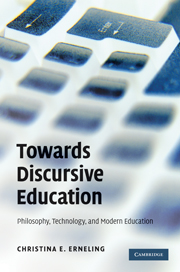Book contents
- Frontmatter
- Contents
- Acknowledgements
- Introduction
- 1 The infantilisation of learning
- 2 Educational technologies and pedagogy
- 3 Piaget and natural learning
- 4 Piaget's conception of the framework: from instincts to intentionality
- 5 The infant as scientist
- 6 The socio-cultural approach to learning
- 7 Towards discursive education
- Appendix
- References
- Index
1 - The infantilisation of learning
Published online by Cambridge University Press: 05 June 2012
- Frontmatter
- Contents
- Acknowledgements
- Introduction
- 1 The infantilisation of learning
- 2 Educational technologies and pedagogy
- 3 Piaget and natural learning
- 4 Piaget's conception of the framework: from instincts to intentionality
- 5 The infant as scientist
- 6 The socio-cultural approach to learning
- 7 Towards discursive education
- Appendix
- References
- Index
Summary
INTRODUCTION: THE PROBLEM SITUATION
Computers and learning
During the last twenty to thirty years, schools have put a monumental amount of money and effort into introducing computer technology. There have been many reasons put forward to justify this, including saving money in the long run, providing education to groups outside traditional schools or to remote regions, preparing pupils for new working conditions, and so on. But one of the main motivations has been the claim that the technology improves the conditions for learning by making education more flexible in its adjustment to the individual, more like real life, more fun, and thus more motivating. It promotes the pupil's own engagement and active involvement in his or her own education. Underlying such beliefs is, I argue, a view that pedagogical thinking has appropriated from developmental cognitive psychology, namely the idea that all learning is like early infant learning, that is, all learning is grounded in biological abilities and is to a large extent innate, automatic, and unconscious. The task of the school is to mimic the conditions of this early learning situation so that learning in schools will improve. Computer technology is not just one resource that is believed capable of doing this, but also one that will succeed where others have failed.
The computer, e-mail, Internet, multimedia, games, and virtual reality technologies are all seen to be bridging the gap between schools and real life (see for example Papert, 1980/1983, 1993; Schank and Cleary, 1995).
- Type
- Chapter
- Information
- Towards Discursive EducationPhilosophy, Technology, and Modern Education, pp. 4 - 39Publisher: Cambridge University PressPrint publication year: 2010



